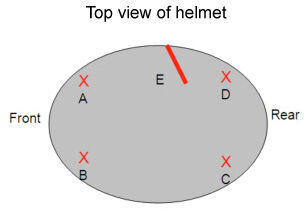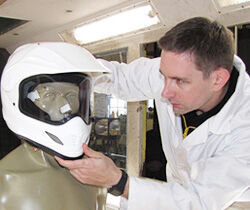
Crash Protection
The CRASH safety test program assesses and compares motorcycle helmets in terms of their ability to protect the wearer's head in a crash on a typical Australian road and how comfortable the helmet is to wear.
The helmet's crash protection performance is assessed using the following criteria:
- They must have adequate impact performance.
- They must remain on the wearer's head during the crash.
This video shows the range of CRASH safety testing
Helmets must have adequate impact performance
The helmet must be able to reduce the impact of a crash and manage the acceleration of the head to minimise injury. To achieve this, the helmet must:
- Cover the frontal and temporal areas of the head
- Not disintegrate during the impact and,
- Be able to minimise injury to the head from impacts with different types of objects and different heights.
In all tests, a simulated head with many characteristics of the human head is used to facilitate the measurement of various forces in the crash test. The data gathered is then assessed using recognised protocols, and scores are determined for each specific test.
A helmet's ability to mitigate the effect of a blow to the head is assessed by dropping it onto a hard surface representative of the roadway, and a 'hard metal edge' such as a kerb, roadside barrier or corner of a vehicle.
These test surfaces (anvils) are termed 'flat', 'hemispherical' or 'kerb'. CRASH uses modified tests comprising high and low speed impacts (compared to AS/NZS 1698 requirements) using a flat surface and higher speed impact than UN/ECE Regulation 22* using a simulated kerb surface.
In tests where the helmet is dropped onto a flat surface, the helmet mounted on a simulated head is dropped from heights of 0.8 metres and 2.5 metres (AS/NZS 1698 uses a drop height of 1.83 metres). The helmets are evaluated in terms of their ability to reduce impact to the head, maintain the helmet structural integrity, and ensure the chin strap is still working properly after the test. The test matrix and impact locations are shown in the figure and table below.
| Test procedure | Location |
| Energy reduction in high speed impact on flat surface – Impact 1 | A |
| Energy reduction in high speed impact on flat surface – Impact 2 | C |
| Energy reduction in low speed impact on flat surface – Impact 1 | B |
| Energy reduction in low speed impact on flat surface – Impact 2 | D |
| Energy reduction in high speed impact on kerb surface | E |
Ideally, a helmet should be able to absorb maximum impact energy while maintaining a tolerable acceleration of the head inside the helmet. The testing program measures the ability to maximise the energy impact absorbed by the helmet. This is assessed by dropping the helmet onto a flat and kerb anvils and measuring the acceleration levels of the head.
Below is a slow motion clip of a linear impact test onto a flat anvil.
And a slow motion clip of a linear impact test onto a kerb anvil.
Helmets must remain in place during the entire crash sequence
Another factor necessary for a helmet to be effective during a crash is that it remains in place during the crash. The helmet should also remain in place for any impacts that follow the initial crash. Helmets are assessed in terms of their ability to stay on the wearer's head and minimise the rotation of the helmet so it protects the most important parts of the skull. This is assessed by rolling the helmet off the simulated head by applying an upward force at the centre rear base of the helmet. In testing from 2017 onwards an upward force will also be applied at the centre front opening of the helmet.
The strength of the helmet's chin strap was also tested to ensure that the chin strap remained intact and did not stretch to a point where the helmet would come off during a crash. The chin strap was tested by dropping a 10kg weight from a height of 750mm, resulting in a force being applied directly to the strap. This test was derived from UNECE 22.05. This test was discontinued from 2017 onwards.
*Uniform Provisions Concerning the Approval of Protective Helmets and of Their Visors for Drivers and Passengers of Motor Cycles and Mopeds.
Oblique impact helmet testing
A new test component was introduced in 2017 to measure a helmet’s angular/oblique impact energy management capability, testing the helmet as it falls onto a moving test surface. This test simulates a rider’s helmeted head striking and skidding along the road, such as when a rider is ejected from a moving motorcycle. A good performing helmet should have a protection system that reduces the rotational forces from the impact to the head.
In this test, the helmet is fitted onto a Hybrid III dummy head with measuring instruments attached. The helmeted dummy head is then dropped from a height of 1.4 metres to strike a platform that moves horizontally at 35 km/h. Each helmet is tested at two impact locations, one near the centre of the forehead, and the other on the temple.
Below is a slow motion clip of an angular/oblique linear impact test onto a moving platform.
Due to the changes in the test methods, helmet ratings from 2017 onwards cannot be compared to the pre-2017 ratings.
Comfort Level
To be worn correctly a helmet must be comfortable to wear, functional in use and easy to put on and remove. The helmets' comfort levels are assessed in terms of their ability to:
- Provide a good peripheral view.
- Reduce wind noise.
- Minimise wind resistance.
- Encourage ventilation inside the helmet.
- Be lightweight
- Have a visor that does not easily fog up and stops water from coming in.
The helmet's ability to reduce noise, to minimise the wind resistance and to encourage ventilation inside the helmet was assessed in a wind tunnel at a simulated riding speed of 100 km/h. The helmet was fitted on a mannequin designed for acoustic measurement. The mannequin was equipped with a specially designed microphone placed inside one of the mannequin's pinnas (ears). The wind resistance was measured using the force plate which is part of the wind tunnel and the ventilation was measured by measuring the pressure drop on the face and crown areas of the mannequin.
This video gives an overview of the CRASH comfort level test suite.
Rating System
CRASH awards a star rating from 1 to 5 for each motorcycle helmet, following independent crash protection and comfort assessments by independent specialist laboratories.
The rating system has gone through several significant changes with the aim of improving the level and clarity of information provided to motorcyclists. The rating system now provides a five-star rating system that better reflects the comparative performance beyond that required by AS/NZS 1698 or UNECE 22.
In the crash protection assessments, the helmets were rated based on their individual performance test results. The results were ranked and weighted based on their importance in reducing the risk of head and brain injuries in a crash.
A new test component was introduced in 2017 to the crash protection assessments to measure a helmet’s oblique impact energy management capability. The rating system was reviewed and redistributed as a result.
The crash protection ratings for 2017 onwards are as follows:
- Energy reduction in a higher speed crash on a flat surface (30 per cent)
- Energy reduction in a higher speed crash on kerb surface (15 per cent)
- Energy reduction in a lower speed crash on flat surface (15 per cent)
- Helmet's ability to stay in place in a crash / dynamic stability (15 per cent)
- Helmet coverage (10 per cent)
- Oblique impact energy management (15 per cent)
The crash protection ratings pre-2017 were as follows:
- Energy reduction in a higher speed crash on a flat surface (30 per cent)
- Energy reduction in a higher speed crash on kerb surface (25 per cent)
- Energy reduction in a lower speed crash on flat surface (15 per cent)
- Helmet's ability to stay in place in a crash / dynamic stability (10 per cent)
- Helmet coverage (10 per cent)
- Helmet chin-strap's strength (5 per cent)
- Helmet's ability to minimise rebound (5 per cent)
For the comfort level performance, the helmets were rated using comfort features which were considered important by motorcyclists. These features were ranked based on results from a 2010 survey conducted by the European project COST 357–PROHELM (Accident Prevention Options with Motorcycle Helmets) involving 598 motorcyclists. The study found 71 per cent of the riders wore a helmet that was not of the right size and 69 per cent of the respondents reported discomfort using the helmet.
The most common complaints related to noise inside the helmet, followed by the visor fogging up, and the ventilation system not working adequately. The remaining features are ranked in the following order: Aerodynamics (neck loading), helmet weight, peripheral vision and visor's ability to seal out moisture.
In 2017 the comfort level rating system was also reviewed and redistributed. Due to these changes the test ratings from 2017 onwards cannot be compared to ratings pre-2017.
The comfort level ratings for 2017 onwards are as follows:
- Visor’s ability to resist fogging up (10 per cent)
- Ability to seal out weather (10 per cent)
- Noise inside helmet (25 per cent)
- Ventilation inside helmet (20 per cent)
- Aerodynamic neck loading (15 per cent)
- Helmet weight (10 per cent)
- Peripheral view (10 per cent)
The comfort level ratings pre-2017 were as follows:
- Operation and fit (20 per cent)
- Visor’s ability to resist fogging up (10 per cent)
- Ability to seal out weather (10 per cent)
- Noise inside helmet (20 per cent)
- Ventilation inside helmet (17.5 per cent)
- Aerodynamic neck loading (10 per cent)
- Helmet weight (5 per cent)
- Peripheral view (7.5 per cent)


